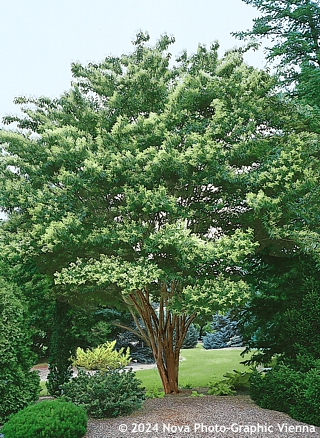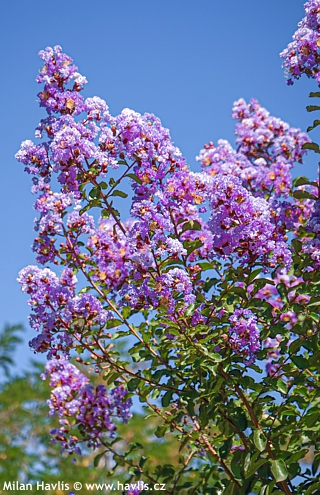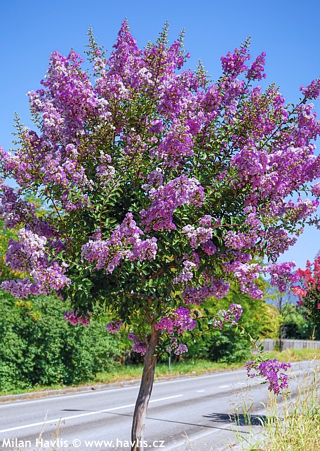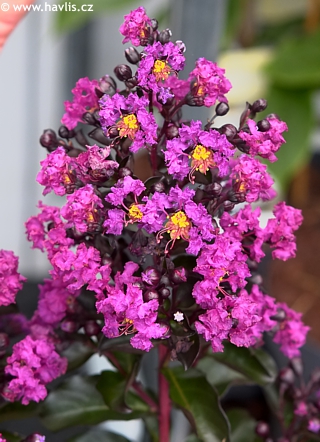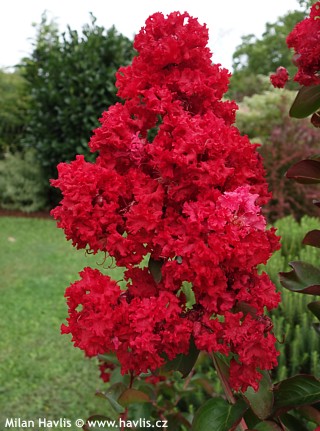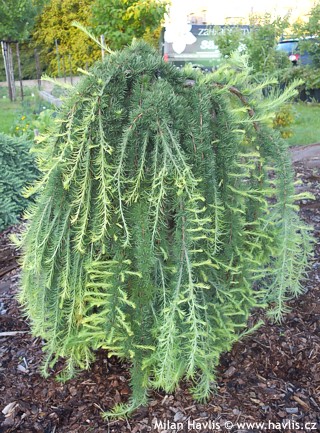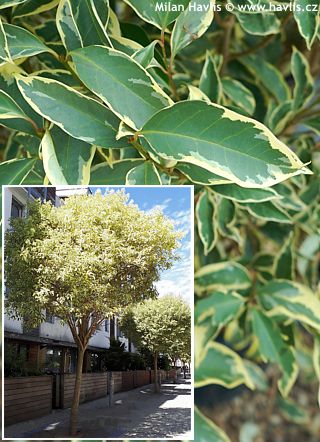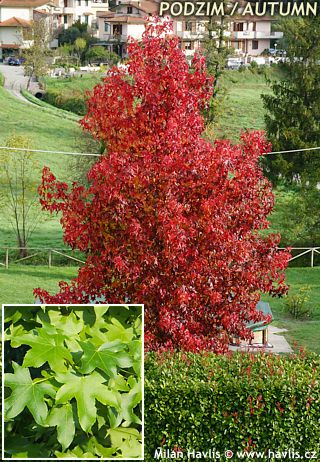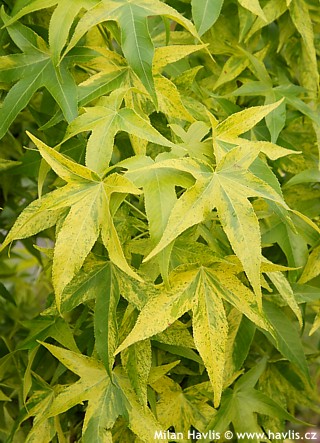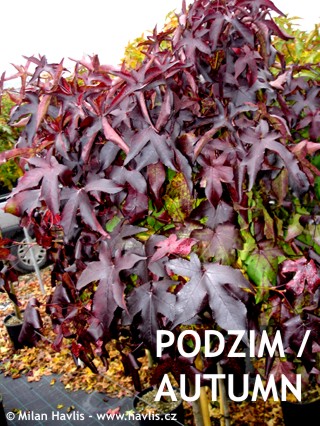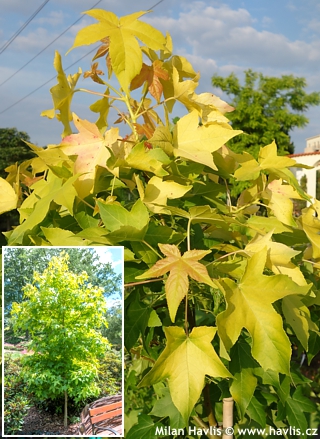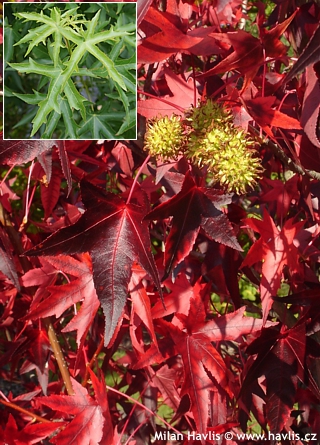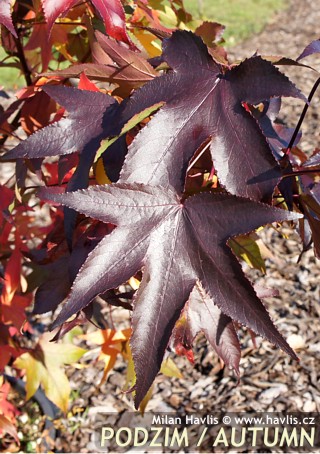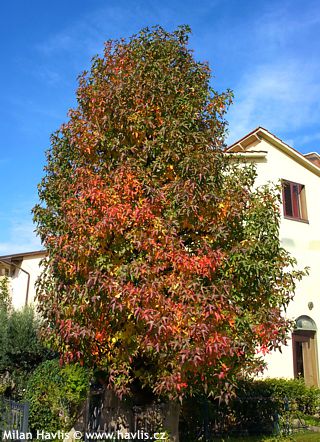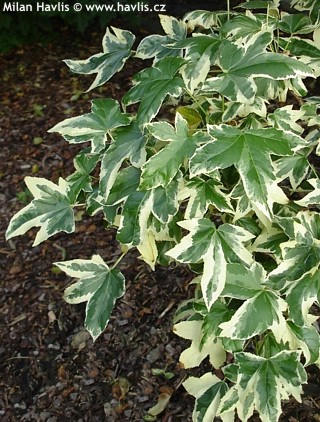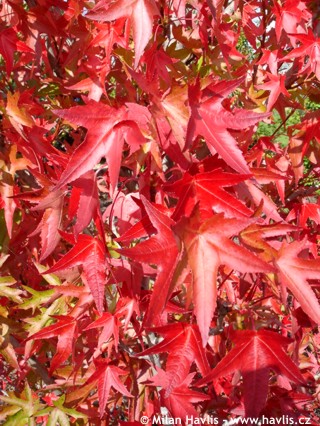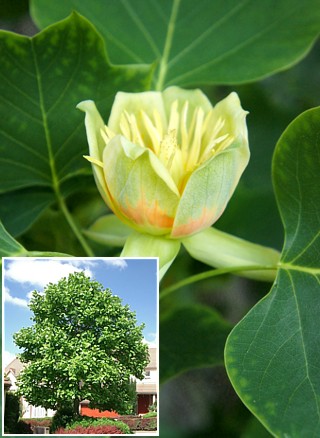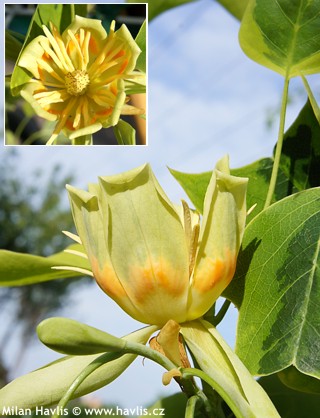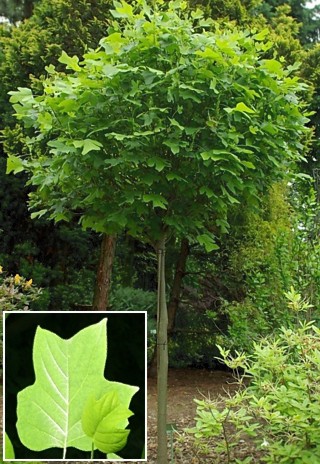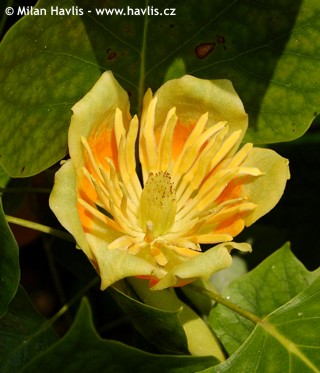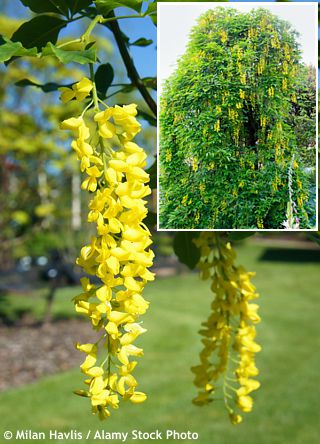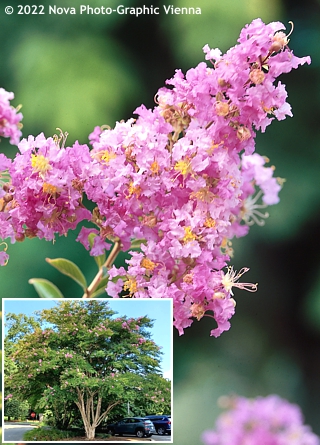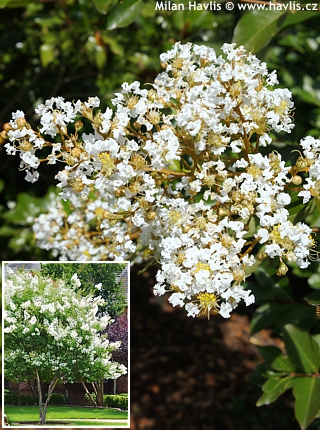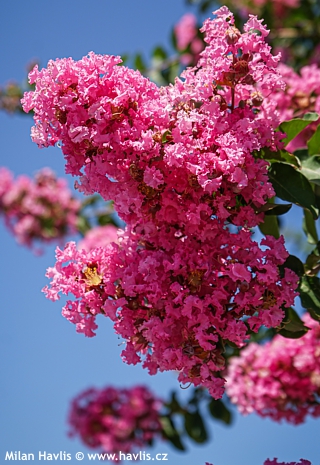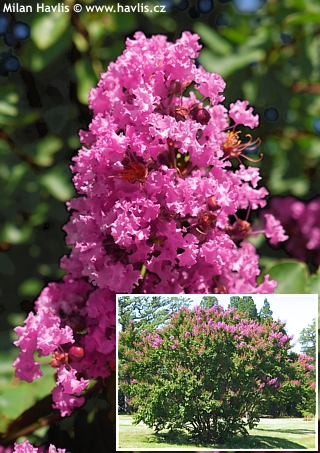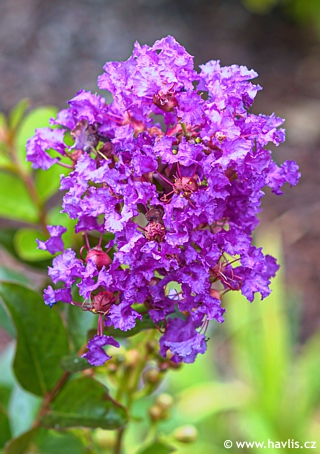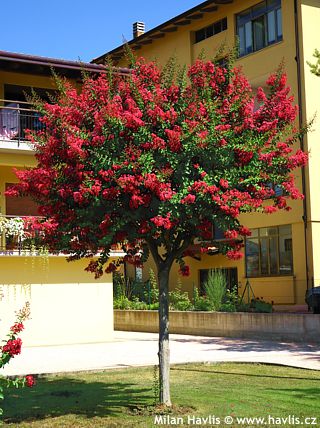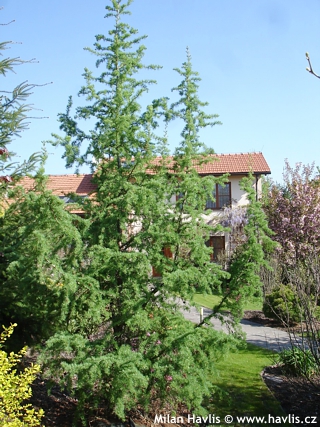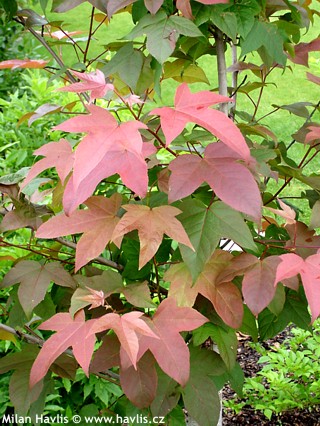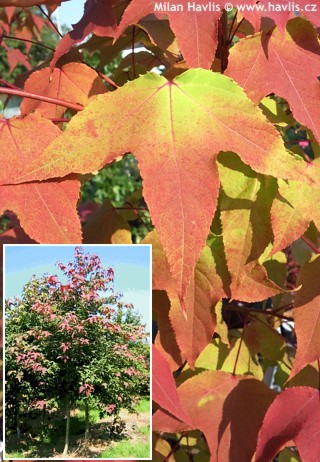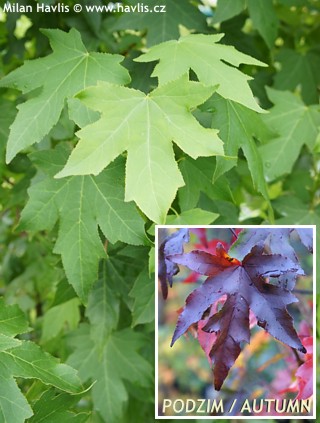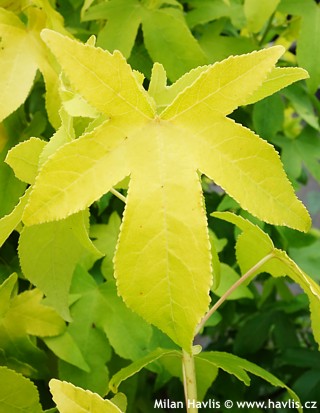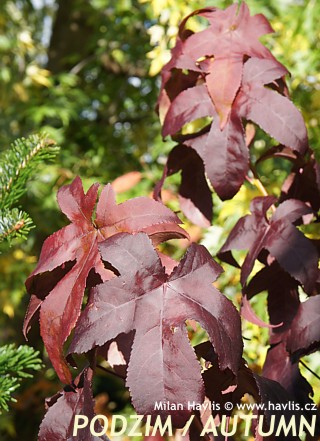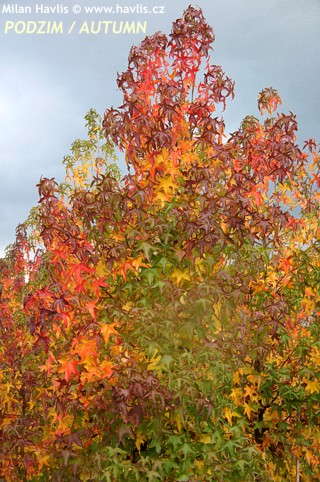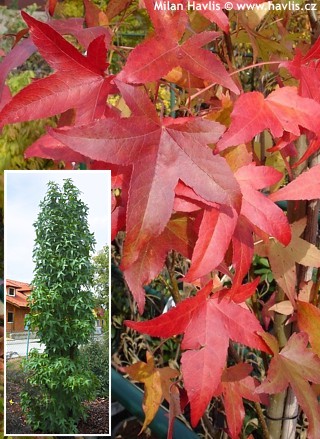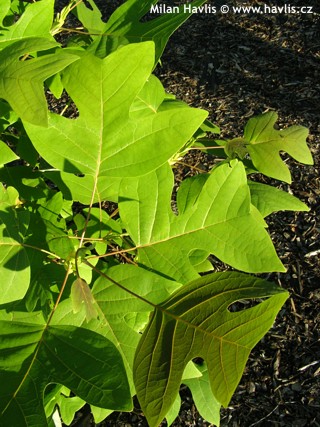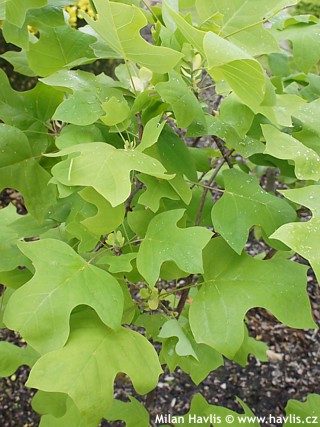CURRENTLY IN STOCK:
Tuscarora is another successful cold-hardy lagestremia hybrid variety from the US National Arboretum. It has bright coral pink to scarlet red flowers composed in upright panicles and appear, according to the quality of the summer, from August to September or October. The leaves are deciduous, glossy ...

VIII - IX

2 - 5m

2 - 4m

full sun

7 (down to -23°C)

for zone 5+6

for zone 7
Fantasy is a fast-growing Japanese crepe myrtle variety. It makes white flowers arranged in short, upright panicles. They are not fragrant and appear, according to the quality of summer, from August to September in C.E. climate. The leaves are deciduous, glossy, tinted mahogany red as they emerge an ...

VIII - IX

3 - 6m

3 - 4m

full sun

7 (down to -23°C)

for zone 5+6

for zone 7
Benoit is an Indian crepe myrtle variety with rich mauve purple flowers and attractive colouring of new leaves. The flowers are arranged in upright panicles, non-scented, and appear, according to the quality of summer, from August to September in C.E. climate. The leaves are deciduous, glossy, brigh ...

VIII - X

2 - 5m

2 - 4m

full sun

7 (down to -23°C)

for zone 5+6

for zone 7
Powhatan is an Indian crepe myrtle variety (not a hybrid) developed at the US National Arboretum. It is a compact, moderately fast-growing shrub or small tree with a dense, almost impenetrable canopy with slightly arching branches on older specimens. The flowers are lilac mauve to pale lavender viol ...

VIII - IX

2 - 5m

2 - 4m

full sun

7 (down to -23°C)

for zone 5+6

for zone 7
RHAPSODY IN BLUE is an attractive crape myrtle variety from the Play It Again® series introduced in 2022. The series comprises of varieties with double flowering on the same panicle and in a few cases dark foliage as a bonus. RHAPSODY IN BLUE bears deep purple flowers with mauve hues against a ...

VIII - IX

2 - 3m

1,5 - 2m

full sun

7 (down to -23°C)

for zone 5+6

for zone 7
DYNAMITE® is possibly the reddest crepe myrtle variety known to trade. It produces large (30x20 cm), upright panicles of the richest red shade you may have seen. Flowering begins in late July or early August and continues till the last sunny and warm days of autumn.
The deciduous leaves are le ...

VIII - IX

1,5 - 3m

1 - 1,5m

full sun

7 (down to -23°C)

for zone 5+6

for zone 7
Weeping form of deciduous larch Stiff Weeper is one of the most sought-after conifers in our country. It has strictly pendent branches with no horizontal growth. The crown looks like a head of a long-haired girl. The needles are about 4 cm long, bright green with a silvery blue shade, turning yellow ...

0,5 - 2m

0,5 - 1m

full sun

4 (down to -34°C)

for zone 5+6

for zone 7
Excelsum Superbum is a highly attractive, variegated form of glossy privet. It makes large, up to 15 cm long and 6 cm wide, ovate to oval, pale dark green leaves abundantly variegated butter yellow, often extended to the midribs. Directly contradicting its botanical name they are NOT glossy, they ar ...

IX - X

2 - 5m

1 - 3m

full sun

8 (down to -18°C)

for zone 5+6

for zone 7
This is the species of sweetgum. Its maple-like, star-shaped leaves are medium-deeply or deeply cut and have fresh green colour. As it is reproduced mainly by seeds the plants often vary even if grown from seeds of the same parent. This results in plants having slightly different characteristics suc ...

8 - 15m

3 - 6m

full to partial sun

5 (down to -29°C)

for zone 5+6

for zone 7
Aurea is a sweetgum variety with varigated leaves showing irregular splashes of yellow. They turn pink and purple in autumn.
In gardens with limited space for roots it seldom grows taller than 10m, however, in parks and in southern countries you may encounter much taller and obviously very old spec ...

8 - 15m

4 - 8m

full sun

5 (down to -29°C)

for zone 5+6

for zone 7
A collectors’ item not only for collectors is this sweetgum. An interesting novelty called Golden Sun has quite a unique feature never found on any other sweetgum before: golden yellow branches. The colour is present on new twigs as well as up to about 3 year-old branches. Leaves are usual, 5- ...

4 - 6m

2 - 3m

full sun

5 (down to -29°C)

for zone 5+6

for zone 7
If you like sweetgum and you are afraid of its size in maturity try this one. Gum Ball is a great variety with dwarf growth and reduced size. After 10 years it can grow to some 2.5m with a total of 3m in maturity. Its crown is quite regular even without pruning.
The leaves are identical to basic s ...

2 - 3m

1,5 - 2m

full to partial sun

5b (down to -27°C)

for zone 5+6

for zone 7
Naree sweet gum was found as a spontaneous mutation of the species in Australia and did not reach Europe until after 2000 – it was first introduced by the Junker’s Nursery from Milverton, United Kingdom, in 2002. It belongs among a few unique varieties with yellow leaves. These are decid ...

6 - 10m

3 - 6m

full sun

5 (down to -29°C)

for zone 5+6

for zone 7
Stella is an attractive sweet gum selection, similar to Stared variety, yet a little broader in habit. Its leaves are beautiful, 15-20 cm large, deciduous, star-shaped, deeply lobed, green in summer and rich scarlet red and deep burgundy red in autumn for almost 2 months. An extra feature is the lea ...

6 - 12m

2 - 4m

full sun

5 (down to -29°C)

for zone 5+6

for zone 7
Théa is an attractive variety of sweetgum selected for its autumn foliage colour and smaller size. Its leaves are large, typically 5-lobed, rich green, turning to long lasting shades of bright red and burgundy purple in autumn. The tree grows slowly or moderately into a narrowly pyramidal shape. Unl ...

5 - 8m

2 - 3m

full sun

5 (down to -29°C)

for zone 5+6

for zone 7
Worplesdon is a popular sweetgum variety among both growers as well as customers. It is a reliable and hardy selection that grows well without any additional maintenance. It has deep green, deciduous leaves that are star-shaped, deeply lobed, often with a pair of small teeth beneath each tip. The mo ...

6 - 12m

3 - 6m

full sun

5 (down to -29°C)

for zone 5+6

for zone 7
Manon is a variegated form of sweetgum. It has star-shaped leaves with white margins that may turn pink in autumn. The leaves look very similar to variegated forms of ivy. This tree grows slowly into a narrowly pyramidal form. Highly decorative.
Another nice feature is the fruit. Formed in about 3 ...

5 - 7m

2 - 4m

full to partial sun

5b (down to -27°C)

for zone 5+6

for zone 7
Stared is one of the most recent varieties of sweetgum with leaves cut so deep like a too low neck on a frock of a lady who forgot she was going to attend a charitable ball “Help Africa” and not a teenager party “Miss Bikini – Monokini”. Liquidambar leaves have a unique ...

5 - 7m

1 - 2m

full sun

5b (down to -27°C)

for zone 5+6

for zone 7
Belonging to the same family as magnolia, common name tulip tree may be misleading since this name is often used for magnolias with saucer-shaped flowers. Hence gardeners rather use its other name yellow poplar. This is the tree with huge lyra-like, saddle-shaped leaves which do appear to miss a lob ...

VI - VII

25 - 30m

10 - 15m

full sun

5 (down to -29°C)

for zone 5+6

for zone 7
Belonging to the same family as magnolia, common name tulip tree may be misleading. This is the tree with huge lyre-shaped, deciduous leaves which do appear to miss a lobe. This variety is called Aureomarginatum because its leaves are decorated with broad creamy-yellow margins that turn light green ...

VI - VII

15 - 20m

6 - 10m

full sun

5 (down to -29°C)

for zone 5+6

for zone 7
Edward Gursztyn is a compact or almost dwarf variety of yellow poplar. It makes a uniform, rounded canopy and very hadsome, typical saddle-shaped leaves. They are deciduous, green in summer and yellow in autumn. No flowers have been observed so far. It needs no pruning for a nice shape but ou can tr ...

2 - 4m

1,5 - 2m

full sun

5b (down to -27°C)

for zone 5+6

for zone 7
Fastigiatum is a columnar variety of yellow poplar tree / tulip tree which has two advantages as opposed to the species. First - it is narrower and will fit into a mid-sized garden. And secondly, and for most of us perhaps more importantly, it flowers from very young age. As opposed to encyclopedias ...

VI - VII

7 - 13m

2 - 3m

full to partial sun

5 (down to -29°C)

for zone 5+6

for zone 7













